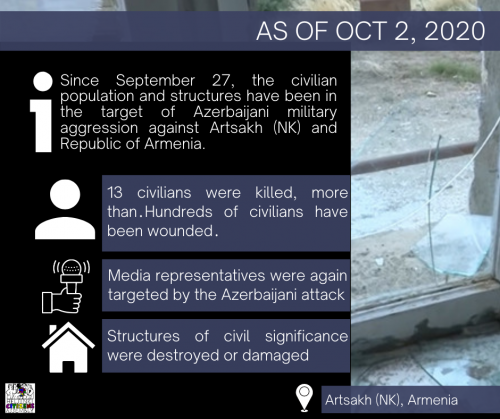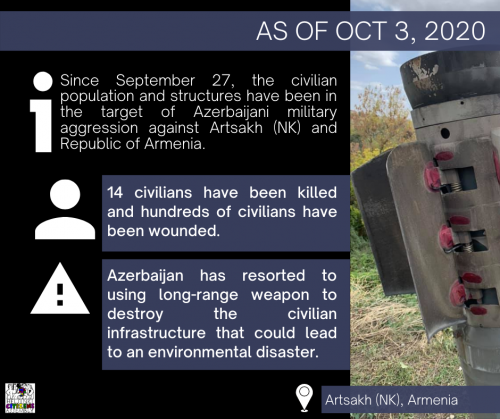This fact-finding report has been prepared by the Helsinki Citizens’ Assembly of Vanadzor, the Law Development and Protections Foundation, “Protection of Rights without Borders” Non-governmental Organization.
The development of report was supported and coordinated by the Open Society Foundations-Armenia.
This fact-finding report documents the war crimes and other violations of international humanitarian law (IHL) and human rights norms that occurred during, and consequential to the 44-Day War waged by Azerbaijan, principally against the population of Artsakh (a.k.a. Nagorno-Karabakh), during the fall of 2020. The evidence presented here is based on meticulous data collection and analysis from multiple sources of information. The result is substantiated documentation of war crimes and human rights violations, as well as a set of recommendations to relevant stakeholders for remedying the situation.
In the framework of this endeavor, a total of 879 witnesses were consulted, and indepth interviews were conducted with 359 of them while reviewing already reported as well as unreported incidents of violations. In order to ensure the objectivity of the report, testimonies were corroborated by evidence and analysis retrieved from other sources, such as video and photographic materials, assessments by military intelligence experts, other human rights reports, and official government reports.
The collected data is analyzed in the context of respective legal norms, and, as a result, it is argued that Azerbaijan has committed war crimes, as well as violations of the right to life, freedom from torture and ill-treatment, rights to health, private and family life, and property, and crimes against the environment and cultural heritage. In particular, the report shows that Azerbaijan has targeted journalists, employed mercenaries, engaged in illegal means and methods of combat, and some of these practices amount to ethnic cleansing.
These crimes and violations had a systemic nature and a clear intent. The Azerbaijani side has been unwavering in its jingoistic attitude towards the people of Artsakh and their struggle for self-determination. Having a maximalist position, the government of Azerbaijan limited the space for a peaceful resolution and made preparations for a military “solution.” For decades, it propagated Armenophobia, constructing an image of Armenians as the radical “other.” Humiliating and destroying this “other” has become the ideological foundation for the official Azerbaijan, using all the means for seizing territories and eradicating the Armenian presence there.
Specifically, 193 communities have already been emptied of their native Armenian population. During the 44-Day War, the Azerbaijani side took deliberate measures to make it impossible for thousands of civilians to remain in their homes, through indiscriminate shelling, targeting of civilian infrastructure and inducing fear. Both civilians and combatants were taken as hostages and prisoners of war (POWs), and they were either executed, tortured, or otherwise abused.
The report details the violations of right to live, torture and ill-treatment by Azerbaijani forces and demonstrates that these have been systemic during the war and its aftermath. In total, 19 cases of illegal execution of POWs are documented in the report, including civilians. Furthermore, the Azerbaijani side did not distinguish between civilians and combatants, evidenced by indiscriminate attacks in violation of IHL obligations. For instance, the use of high fragmentations explosive materials has been identified during field visits and analyses of open-source data. The report also shows that multiple residential buildings and civilian infrastructure objects were bombed by the Azerbaijani side. Interviews were carried out with four former POWs, who provided details of their torture and ill-treatment.
The victims, often elderly, were beheaded alive, mutilated, or otherwise tortured.
The report also provides evidence of violations of the rights to health, right to private and family life, as well as right to property. In particular, it is documented that the conflict has caused physical as well as mental injuries for hundreds of Armenians. Besides, healthcare services for fighting the Covid-19 pandemic became paralyzed due to Azerbaijan’s attacks, and following social distancing rules was not possible, as people were escaping bombardments in crowded shelters. There are multiple cases of family separations, disruptions in the education processes of children, worsened living conditions, and economic hardship issues caused by the war. Violations of the right to property are widespread. Many are unable to reside in their homes in communities that are currently under Azerbaijan’s control. Due to rampant Armenophobia, it is not possible for these people to return to their homes. In addition, many families had to flee their homes without being able to retrieve their valuables.
The report also shows that during the war, Azerbaijani forces have also committed environmental crimes and destroyed multiple Armenian cultural heritages. The Fact-Finding Group has identified that they used incendiary weapons, causing many families to flee their communities. It is estimated that around 1800 hectares of forests were destroyed due to these attacks. Besides, there were deliberate attempts at erasing Armenian cultural presence in Artsakh. The report provides evidence of cases, where the Azerbaijani side destroyed Armenian churches and monuments. In other cases, it tried to erase the belonging of these monuments to Armenian heritage.
The report sheds light on the illegal means and methods that the Azerbaijani side used to create the above-mentioned atrocities. It provides detailed reflections on the weaponry used during the war and the acts of targeting civilian populations, residential areas, and infrastructures. For instance, substantial evidence of the use of cluster munition, targeted bombardments of civilian objects by Turkish and Israeli drones, and other illegal methods is demonstrated in the report. In addition, it is shown how Azerbaijan, with the help of Turkey, used Syrian mercenaries during the war.
Lastly, the Azerbaijani side tried to hide these acts of crime and violations by hindering the work of journalists during the war. For example, indiscriminate attacks in civilian areas also created security threats for journalists, and some of them had to leave Artsakh due to those reasons. While Azerbaijan had sufficient information about the presence of journalists in certain areas, it still carried out high-precision attacks, which put the lives of many reporters in danger and caused injuries to some of them.
The war launched by Azerbaijan against the population of Artsakh was a calculated choice. It has been described by international jurist and UN expert Alfred de Zayas as a war of aggression for which Azerbaijan’s President Ilham Aliyev should be held accountable. The war crimes and other violations of IHL and human rights norms documented in this report demand urgent action by the international community not only to render justice to the victims but also to tackle the impunity that continues even after the end of active hostilities. The fact that to date Azerbaijan refuses to return Armenian prisoners of war and uses aggressive and militant tactics that terrorize populations living both in Artsakh and bordering villages of Armenia is to an extent a product of a failed international response to Azerbaijan’s actions. Without accountability, Aliyev’s regime will succeed in its “military solution” as a means of suppressing self-determination, causing ethnic cleansing, and sidelining lasting solutions to the conflict.
Human Rights Violations during the 44-Day War in Artsakh Fact-finding Report




